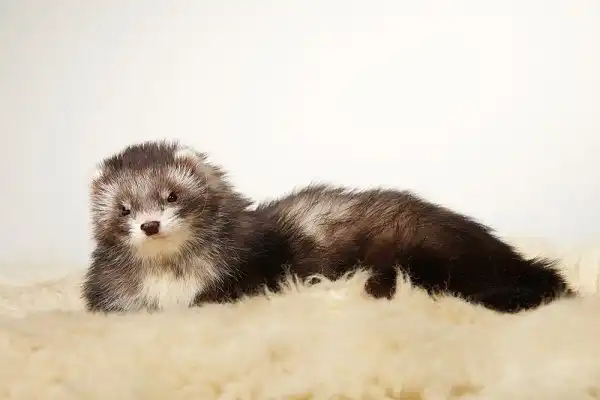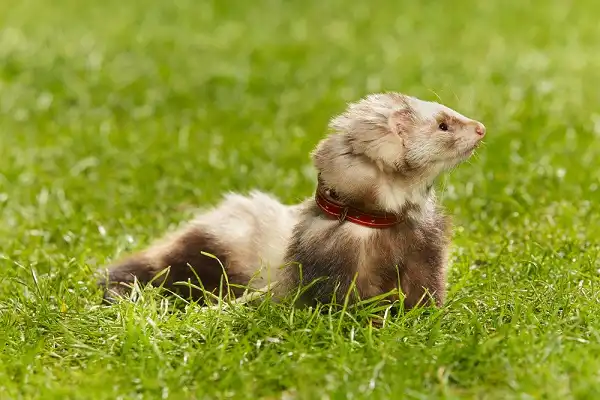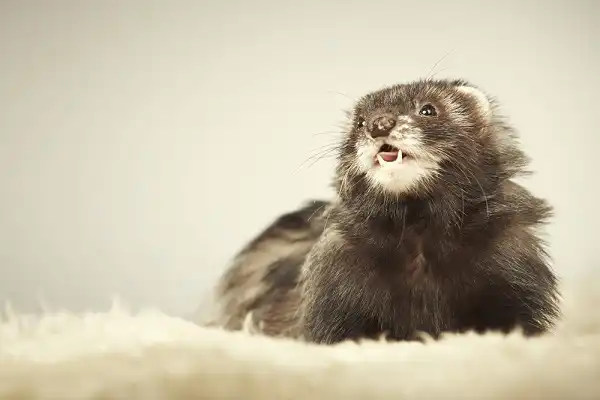Have you ever heard of an Angora ferret? It’s a fascinating creature, a lot like its wild cousin but much cuter with thick, long fur and adorable whiskers. Not only is it fluffy and cuddly looking, but the Angora ferret is also an intelligent and social animal that can actually make great pets. That’s right – if you want to share your home with one of these mammals, they could be the perfect furry companion for you! Today we’re talking all things “Angora Ferret” – from their cute appearance to why they should make such good house pets. Don’t miss out on learning more about these curious creatures!

Angora Ferret Description
The Angora ferret (Mustela putorius angorensis) is a unique breed of ferret that differs significantly from its wild ancestor. Their most noteworthy feature is their long, dense fur that covers the entire body. This luxurious coat can be found in a variety of colors, such as silver, albino, sable, mitts, and cinnamon. It also has a characteristic mane which covers the neck and upper chest area. The muzzle of an Angora ferret is short and rounded with small eyes and big ears set high upon its head. Its tail is much longer than the common ferret and usually lacks any markings on it. Angora ferrets require regular grooming due to their lengthy fur coats which can become matted if not cared for properly. Regular brushing will help remove any debris and prevent mats from forming, while trimming their nails helps keep them from scratching furniture or themselves.
Angora Ferret Habitat
Angora ferrets can make great house pets, as they require much less space than their wild counterparts. These small mammals are naturally very curious and will adapt well to a variety of living environments. As long as they have plenty of room to explore, play and cuddle with their human companions, they will be content. When it comes to habitat requirements for Angora ferrets, a secure enclosure should be provided where they can roam around safely and without the risk of escaping. This could include an indoor cage or an outdoor run with plenty of space for them to move around and explore. The enclosure should also provide protection from extreme weather conditions, such as strong winds or scorching temperatures.
It should also contain several hiding spaces where your furry friend can take shelter if it gets overwhelmed by its surroundings. It is important that you provide your Angora ferret with plenty of toys and other enrichment activities to keep it entertained, especially if kept indoors for extended periods of time. Interactive toys like tunnels, balls, and mazes are all great options as they provide both mental stimulation and physical exercise. Additionally, providing your pet with edible chew items like wooden sticks or rawhide bones is a great way to encourage natural chewing behavior while preventing boredom-related destructive behaviors.
Angora Ferret Diet
The Angora ferret’s diet should be adjusted to suit its specific needs. They are omnivores, so they need a balanced diet of both meat and vegetables. It is recommended that their diet consists of high-quality, natural wet food and dry kibble made from poultry or fish as a source of protein, as well as an assortment of fresh fruits and vegetables for essential vitamins, minerals, and fiber. Additionally, it is important to supplement their diets with fatty acids such as omega-3 and omega-6 to promote healthy skin and coat growth. Ferrets also require taurine in their diets in order to maintain proper cardiovascular health – this can be found in animal sources such as chicken hearts or liver, fish, egg yolks, or commercial supplements available at pet stores. As per usual with other small mammals, pellets are not recommended for Angora ferrets since they contain too much sugar and do not provide the necessary nutrients for the animals. Treats should also only make up about 10% of the total diet and should be given sparingly to avoid weight gain or digestive issues.

Angora Ferret Size
Angora ferrets are small mammals that typically reach sizes of up to 16 inches in length from head to tail. They weigh anywhere from one-and-half pounds to 3 pounds when fully grown, though there are some individuals that can grow larger than this. The males tend to be slightly larger than the females and have broader heads. The Angora ferret has a long, thick coat which helps keep them warm during the winter months, but also helps keep them cool in the summer. This fur is usually white or cream in color with silver or brown tipped hairs throughout the body and tail. Some individuals may even have slight variations of grey or black coloring on their bodies as well.
Angora Ferret Lifespan
The Angora ferret has an average life expectancy of around eight years when provided with proper care and nutrition. However, they can live up to 10 years or more with good care and attention. When cared for properly, their luxurious coat needs regular grooming to keep it looking its best. In order to maintain a healthy life span, they also need plenty of physical exercise as well as mental stimulation through playing with toys and interacting with their human owner. Aside from proper nutrition, other factors that affect the lifespan of an Angora ferret include genetics, environment, and overall health.
Genetics play an important role in determining how long they will live – those that come from healthier generations usually have longer lifespans than those that do not. Similarly, their environment plays a role in their longevity; those kept in overcrowded cages or exposed to extreme temperatures may have shorter life expectancies due to stress-related illnesses or conditions. Finally, overall health is also key; animals that are regularly checked by a veterinarian for issues such as heart disease or kidney problems are less likely to suffer from age-related ailments which can cause premature death.
Angora Ferret Behavior
Angora ferrets are typically known for their playful and sociable personalities, making them ideal companion pets for many families. They are particularly curious creatures who thrive when given the opportunity to explore and interact with their environment. They will often climb around furniture or investigate corners of a room or enclosure, looking for something new to investigate. They also have a mischievous streak and can often be found getting into things they should not be! This is why it is important to keep any potential dangers away from your ferret’s reach, such as cords, cleaning products, or other small objects that could become a choking hazard. Angora ferrets form strong bonds with their owners and love to play and snuggle up close when given the chance. They are highly social animals that do best when kept in pairs or groups – this way, they can keep each other entertained throughout the day while providing companionship. Ferrets have quite an array of vocalizations that they use to communicate with each other as well as humans – most commonly heard are soft chirps or chatters used during playtime.

Angora Ferret Speed
Angora ferrets are known for being inquisitive and energetic, but they aren’t necessarily the fastest of creatures. They have a short-legged body type that limits their speed to around 3-4 miles per hour when running, which is comparable to the average human walking pace. However, in comparison to other small animals such as mice, their speed is much slower – with a top speed of only 8-10 feet per second. Even though they may not be the quickest critters on the block, Angora ferrets can still make up for it with their agility and ability to maneuver around tight spaces. Their long tail helps them balance while navigating through tunnels or narrow pathways with ease. When it comes down to it, Angora ferrets may be on the slow side compared to other creatures – but what they lack in speed, they more than make up for with their fun personality and playful nature!
Angora Ferret Reproduction
Angora ferrets are sexually mature between the ages of 8-12 months, depending on the individual. Before breeding can occur, they must be allowed to go through their natural seasonal cycle which is triggered by shorter daylight hours in the fall and winter months. During this period, males will produce a scent from their anal glands; while females will have swollen vulvas and discharge fluids as signs of heat or estrus. Once these behaviors have been recognized, pairing up compatible ferrets for mating is important for successful reproduction.
However, when introducing two ferrets together that have not met before, it is important to exercise caution and provide them with adequate space so that fights do not break out – this can easily result in injury to both parties. After a successful pairing, the female is typically pregnant for 5-6 weeks before giving birth to a litter of kits or baby ferrets. The average litter size can range from 1-7 kits, depending on the breed and health of the mother. All newborns are born blind with ears closed and without fur; they will start to open their eyes around 10 days after being born, and begin developing fur at about 3 weeks old.
Angora Ferret Hunting
Angora ferrets are natural hunters, using their agile movements and sense of smell to help them locate their prey. They are especially adept at hunting small rodents, such as mice or voles, but can also be seen chasing after lizards and insects. When hunting, Angora ferrets use a combination of stealth and speed to apprehend their quarry. They will watch for a few moments before dashing off in pursuit – often surprising their target with a quick burst of speed! When they catch up to the animal, they will bite down on it with their sharp incisors and hold it tight until it stops struggling. Angora ferrets have been used for centuries for hunting purposes due to their keen senses and ability to find hidden animals in the wild. Not only are they capable of tracking down small game but they can also help flush out larger animals from their hiding places – providing hunters with an easy way to spot potential targets. Additionally, ferrets have been trained to retrieve birds that have been shot by hunters as well as bring back any other items that need retrieving from difficult-to-reach areas.

Conclusion
Angora ferrets are much more than just adorable and playful pets – they are also intelligent, energetic creatures with natural hunting abilities that can bring joy to any home. Whether you want to engage in interactive activities or let your furball use its instincts for a game of hide-and-seek, Angora ferrets provide hours of entertainment while strengthening the bond between both parties. Plus, their unique combination of speed and agility makes them an excellent choice for hunters looking for a reliable companion in the wild. All in all, if you’re looking for an active pet that is capable and loyal then look no further! Angora ferrets have it all.
Frequently Asked Question


